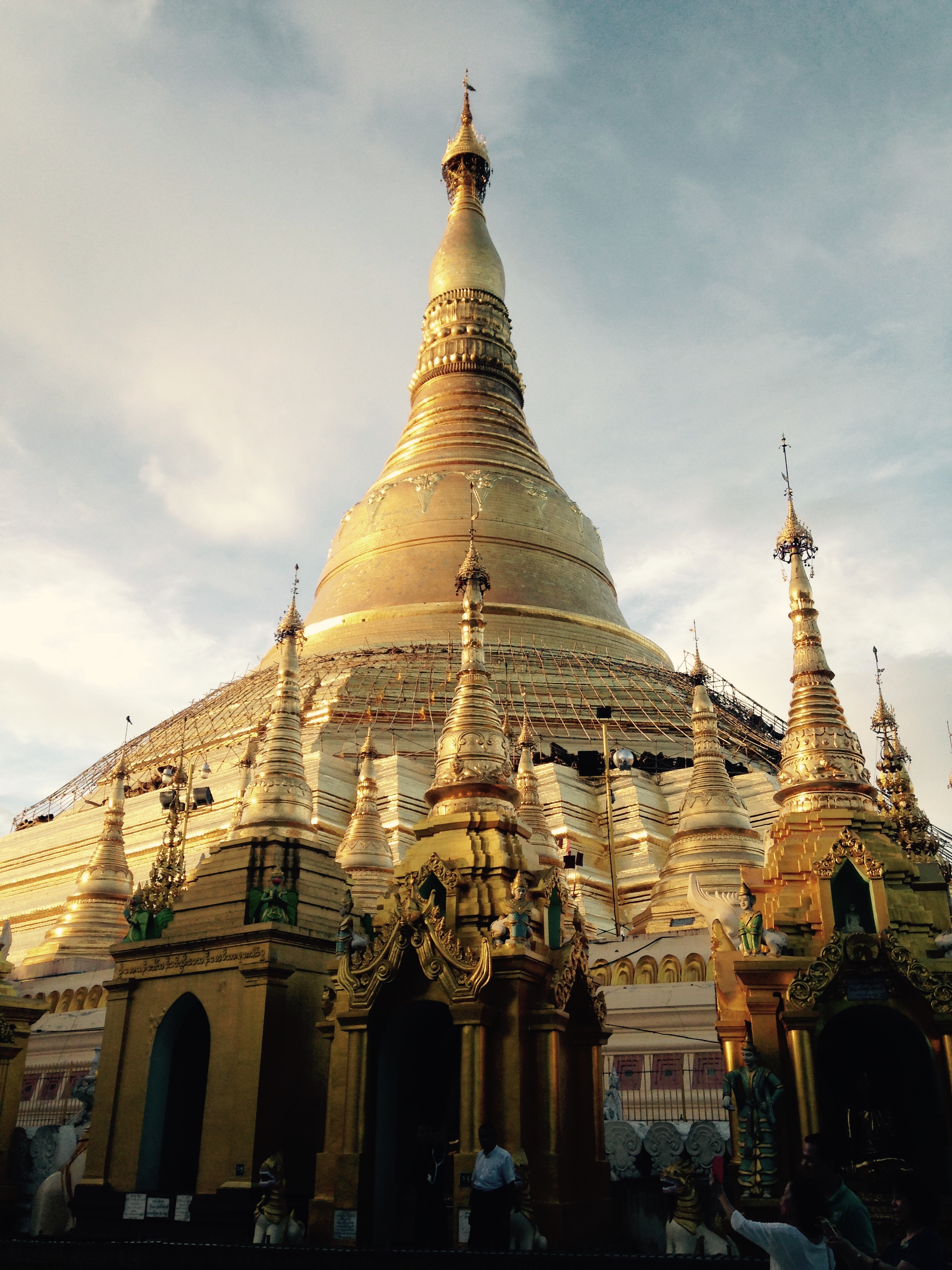First Week in Myanmar
My first week in Myanmar has gotten off to a whirlwind start. After a very long and very sleepless journey – which involved my departing from New York at 7am EST on Wednesday and arriving in Myanmar on Friday afternoon local time, with stops in Los Angeles, Tokyo, and Singapore –, I stumbled bleary-eyed out of the Yangon airport into a crippling wave of heat. To say that it’s hot here is an understatement. With temperatures often surging over 100° and high humidity levels to boot, the heat index is alarmingly high for thin-skinned foreigners like myself. My taxi driver, noticing how quickly I was turning into a pool of sweat, immediately apologized that his vehicle had no A/C.
As we bounced off through the traffic on our hour-long journey to my hotel, I took in the dizzying array of street scenes: women and children, their faces painted with ‘thanaka,’ a cosmetic paste applied in various designs that also protects wearers from sunburn; men laboriously pounding concrete blocks for sidewalk pavement; rickety city buses, filled to the brim with curious faces that stared back at me; plush green foliage spilling out from every crevice; kiosk vendors plying cigarettes, water bottles, and street food; stray dogs scavenging for something delicious in the trash littered on every sidewalk; smiling faces everywhere when we made eye contact. Before we went a single mile, I could tell that the city lacked the infrastructure to deal with the ever-increasing number of cars that have flooded Yangon in the post-trade embargo years. Motorbikes are forbidden in the city, so locals without access to a car must rely heavily on bicycles and ever-abundant taxis (the drivers of which, unfortunately, often adopt ‘fleece the tourist’ tactics) to get around. Driving in Yangon is a bit of a free-for-all, with few rules and perhaps fewer stoplights; cars placed at every angle inch cautiously across intersections, constantly honking at each other – seemingly to no avail –, and pedestrians must step into the thick of the traffic and pray that drivers are paying enough attention not to run into them. Navigating the streets of Yangon is not for the faint of heart!
I took advantage of having a free day on Saturday to look around the city. After visiting the colossal Schwedagon Pagoda and coursing through the narrow streets downtown to take a look at Yangon’s old colonial buildings (many of which are in crumbling disrepair after decades of neglect but some of which have, thankfully, been restored through the efforts of the Yangon Heritage Trust and other groups devoted to preserving the city’s historic architectural legacy), I stopped in the Bogyoke Aung San Market and wandered through the sprawling displays of jewelry, textiles, and crafts. I was delighted to purchase several dresses made from bright, patterned fabrics that had been hand-woven by the Chin, an ethnic group in the Indian-Myanmar border region. At every turn, friendly locals inquired where I was from, whether this was my first time in Myanmar, and how I liked it here. They seemed genuinely eager to learn about the outside world, and they constantly reiterated that I was welcome here. A constant refrain – sometimes expressed in gestures since they lacked the English words – is that they’re very concerned that I protect my fair skin from the blazing sun. If I walk outside without an umbrella, someone inevitably pops up beside me and offers to share theirs.
On Sunday I met with Maung Soe, Thiha, and BD, three of Partners Asia’s Yangon-based employees, who graciously led me around Yangon in search of a local cell phone as well as Burmese-English legal dictionaries. For the next three days I joined Maung Soe and Thiha in the Partners Asia office, where I sat in on several meetings with local non-profit leaders who were, in their own ways, working to promote dialogue both within Myanmar and internationally. One group seeks to document and make public the proceedings of Parliamentary sessions; according to them, this information isn’t widely accessible, and most people are unaware of which topics and laws are currently being debated, or even passed. Another group spreads progressive political messages through theater, traveling around the country to perform for rural audiences and carefully inspiring popular dialogue through artfully-composed rhetorical questioning. I’m struck by their optimism and their conviction that each and every citizen should be involved in Myanmar’s transition into the future. Some commentators have described the country’s march towards democracy as the “Myanmar Spring,” and the swift change from 50 years of oppressive military ruling to president U Thein Sein’s dramatic reforms has indeed been nothing if not startling. The sense of excitement is palpable, as locals can now speak more freely about politics and can brandish memorabilia festooned with images of pro-democracy advocates without having to look constantly over their shoulders. One taxi driver, a former Burmese sailor who kept recalling his ship’s brief stop in California in 1983, informed me that this was the first time he’d ever been able to discuss politics with a foreigner!
Tonight I’ll travel on an overnight bus to Mandalay, where I’ll be stationed for the remainder of my stay in Myanmar. I’m sad to leave Yangon so soon, but I’m looking forward to seeing Mandalay and more of Myanmar generally. Although I’ve been here less than a week, I can already tell that this country and its people are very, very special.
